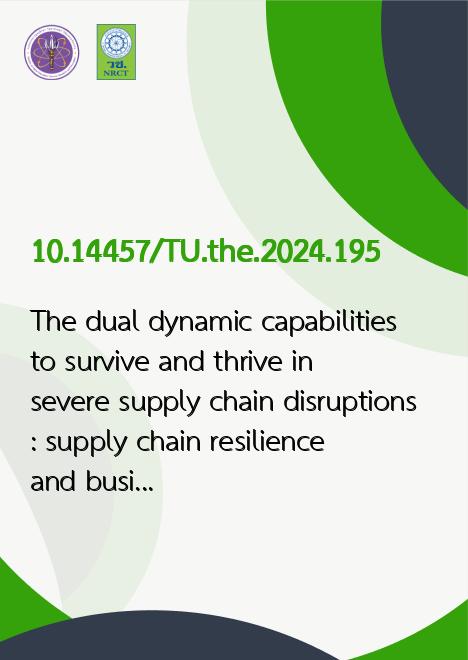
|
The dual dynamic capabilities to survive and thrive in severe supply chain disruptions: supply chain resilience and business model innovation |
|---|---|
| รหัสดีโอไอ | |
| Title | The dual dynamic capabilities to survive and thrive in severe supply chain disruptions: supply chain resilience and business model innovation |
| Creator | Pattama Lenuwat |
| Contributor | Sakun Boon-itt, Advisor |
| Publisher | Thammasat University |
| Publication Year | 2567 |
| Keyword | Supply chain resilience, Business model innovation, Dynamic capabilities, Retail business, Disruptions, การฟื้นตัวของห่วงโซ่อุปทาน, นวัตกรรมโมเดลทางธุรกิจ, ความสามารถเชิงพลวัต, ธุรกิจค้าปลีก, การหยุดชะงัก |
| Abstract | The retail sector is increasingly experiencing frequent and severe disruptions in its supply chain, with the recent COVID-19 pandemic leading to the disappearance of many retailers from the market. Dynamic capabilities have gained significant attention among academics as a means to understand these phenomena. Yet, there remains uncertainty regarding how dynamic capabilities impact firm performance. Concepts such as supply chain resilience, supply chain disruption orientation, and business model innovation are commonly employed to tackle disruption. However, the interconnections between these concepts and their combined influence on firm performance remain unclear. This dissertation is inspired by the aforementioned challenges and seeks to address them by conducting qualitative interviews with four prominent retailers in Thailand in 2022 followed by a quantitative study in 2023 involving 170 retail firms to provide answers to the aforementioned questions. Severe supply chain disruption is selected as a triggering event because it aligns with the context outlined in dynamic capabilities theory, and people tend to have vivid memories of both extreme happiness and shocking events. The results from both qualitative and quantitative relatively align. The findings highlight that during severe disruptions in the supply chain, resource reconfiguration becomes evident, leading to the development of supply chain resilience, akin to sensing, and business model innovation, akin to seizing. The interconnected nature of sensing, seizing, and reconfiguring, as described in the theory is emphasized. The interconnected nature of sensing, seizing, and reconfiguring, as described in the theory is emphasized. Firms cannot solely rely on one or two components for long-term sustainability; instead, all three components must be dynamically utilized to ensure enduring success and prosperity. Absent support from both supply chain resilience and business model innovation, resource reconfiguration does not influence firm performance. However, the quantitative study revealed that the association between resource reconfiguration and the two outcomes might be impeded in the presence of a significant emphasis on supply chain disruption orientation. This dissertation contributes to the literature on dynamic capabilities, supply chain resilience, and business model innovation by clarifying how firms can sustain their performance amidst severe supply chain disruptions. It delves into the mechanism by which resource reconfiguration (reconfiguring), supply chain resilience (sensing), and business model innovation (seizing) collaborate to achieve performance objectives. |
